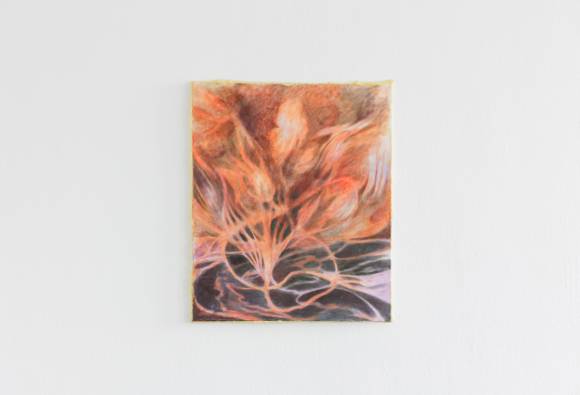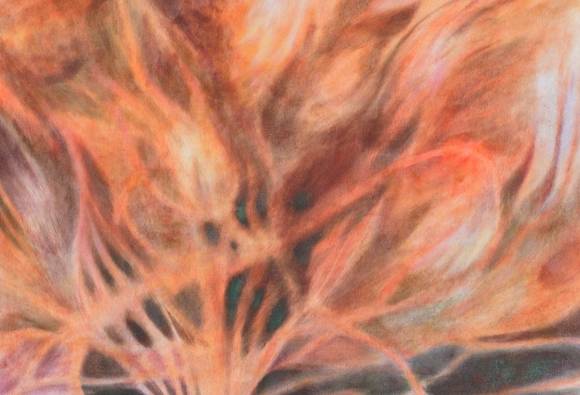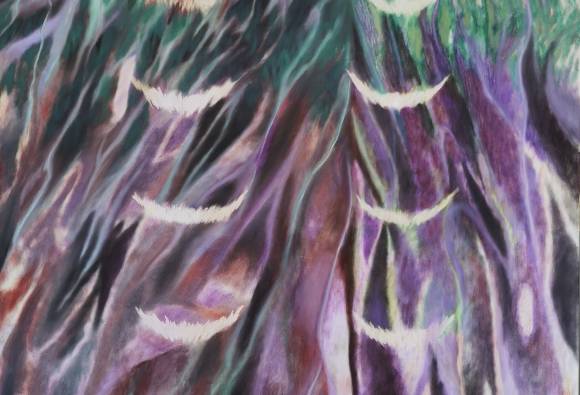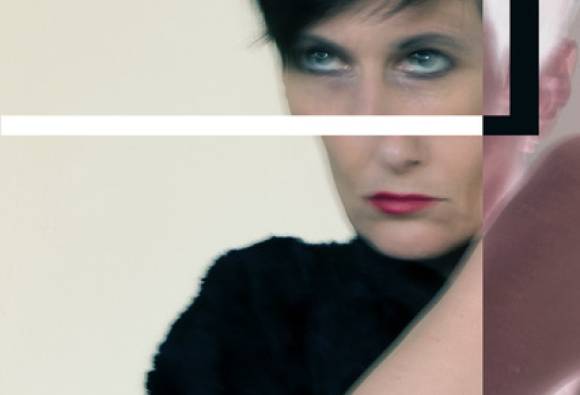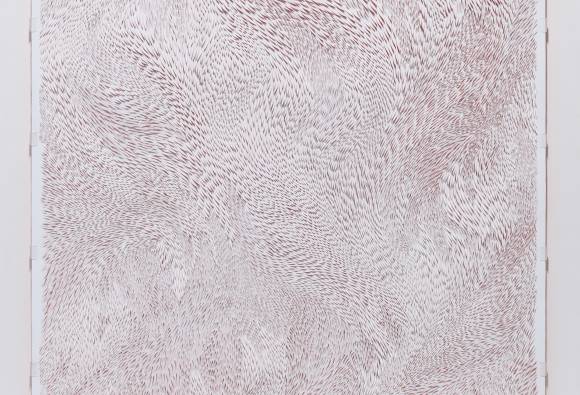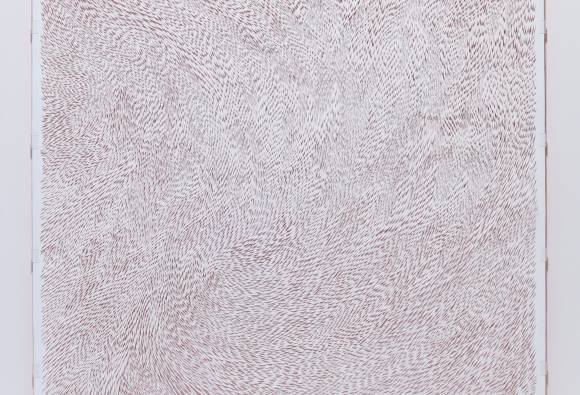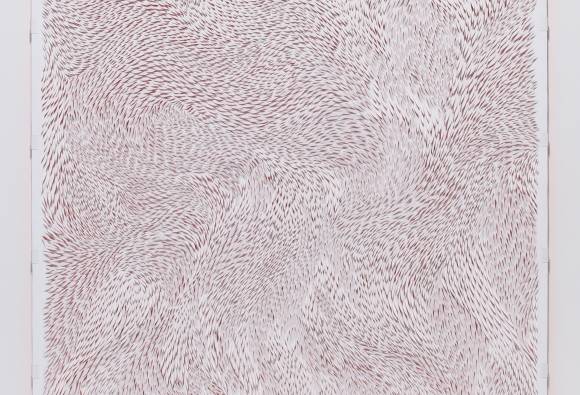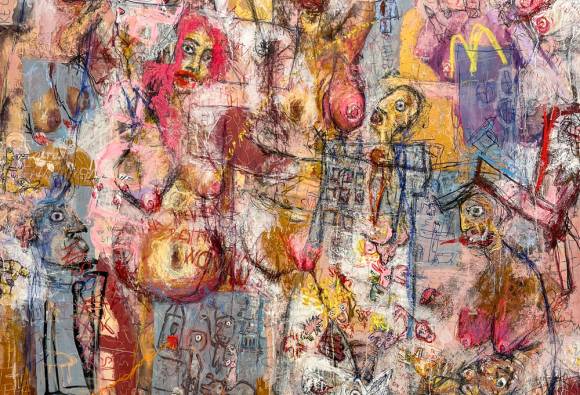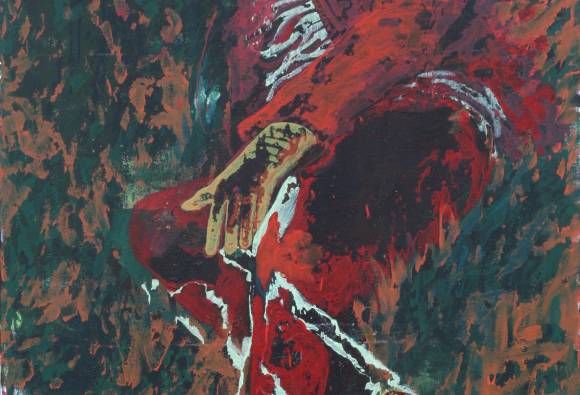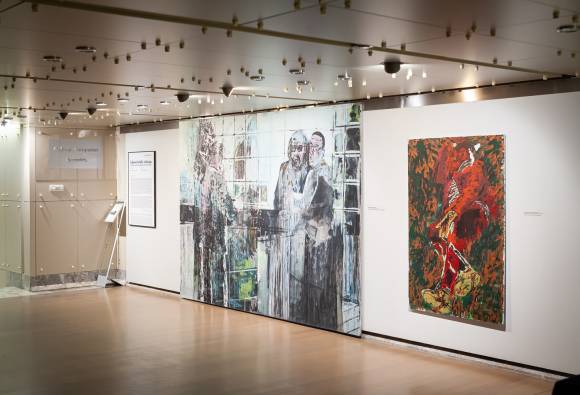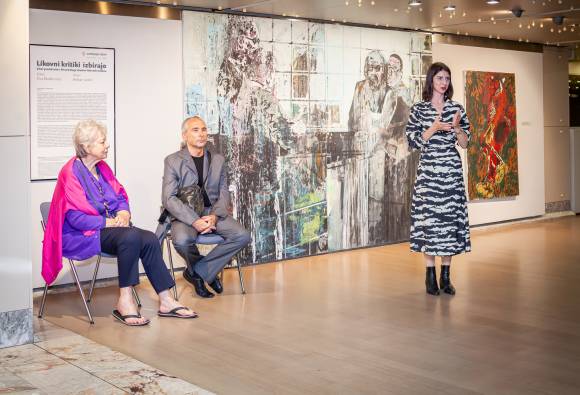
Art Critics’ Choice … Ajda Kadunc
Art Critics' Choice Series - Artist Presentation Series selected by the Slovenian Art Critics Association
Critic: Živa Kleindienst
In her artistic practice, painter Ajda Kadunc examines the prevailing anthropocentric model of thinking and acting, which – in constant pursuit of progress – has plunged humanity into a complex state of social, economic, ecological and, ultimately, moral crisis. In this context, the artist deals with uncertainty and meaninglessness as temporal markers that testify to the disintegration of familiar structures and hierarchies, while at the same time opening up space for the development of new, alternative ways of thinking, living and acting. Alongside new theoretical definitions of nature, life processes, the relationship between the domesticated and the wild, and non-hierarchical interspecies relations, the artist relies on the findings of phenomenology, and day-to-day (contemplative) practices such as gathering, localizing in and moving through space as her main points of reference. The artist follows this logic of movement and embodiment in space also in the very painting process and in creating the pictorial composition. With its processuality, the technique of dry brush oil painting allows her to experiment with forms and images in a gradual and intuitive way. The artist is primarily interested in the disruptions, errors and coincidences that occur in the process and their potential for creating new meanings. Her visual vocabulary emerges in-between the visible and the invisible, the known and the unknown, the real and the imaginary. It consists of varicoloured structures and textures seemingly substantiated by both non-human and human beings. Underground tunnels, plant tendrils, feelers, tentacles, nets, fences, cracks, wounds and tissues spread across the two-dimensional canvas penetrating the very depths of the pictorial space, where – in constant flux – they take their place and assert their presence. Ajda Kadunc's works are fictional and fluid narratives that, with their narrative potential and in creating an open field of meaning, offer a means of accessing possible new realities.
Živa Kleindienst
Ajda Kadunc (1995, Ljubljana) is a visual artist working in painting and installation. She graduated from the Academy of Fine Arts and Design in Ljubljana in 2024. During her studies she also attended Taideyliopiston Kuvataideakatemia in Helsinki. Her solo exhibitions have been held, among others, at Prostor 2^32 (Ljubljana, 2024), the TKALKA Gallery (Maribor, 2024) and, in collaboration with Aleksandra Saška Gruden, the Alkatraz Gallery (Ljubljana, 2023). She has also taken part in several group exhibitions, locally and internationally.
Živa Kleindienst (1987, Maribor) has a BA in in art history. After graduating from the Faculty of Arts in Ljubljana, Kleindienst studied visual culture and curating at Aalto University in Helsinki. She is the Exhibition Programme Coordinator at the UGM Maribor Art Gallery. Since 2024 she has been a member of the Expert Committee on Visual and Intermedia Arts of the Prešeren Fund Management Board. Previously, as a self-employed cultural professional, she collaborated with various national and international galleries, festivals and artists.
Art Critics’ Choice … Ajda Kadunc
Admission free

Art Critics’ Choice ...
Erik Mavrič
Art Critics' Choice Series - Artist Presentation Series selected by the Slovenian Art Critics Association
Critic: Maja Kač
Erik Mavrič ranks among Slovenia’s most important artists working in drawing. Interested primarily in monumental drawing, his preferred medium is charcoal, a technique best suited to the themes of his artistic reflections in terms of form and symbolism. He draws discomforting scenes that appear to be woven from fantasy and a figment of the artist's imagination, but are in fact rooted in his careful observation of the structure of our world. In this series, too, he delves into the dark depths of humanity. However, whereas a few years ago he analysed the self-poisoning of society with allegories of possible dystopian futures, he here remains in the present. We gaze at an utterly violent depiction of the consequences of human self-destructiveness, rooted in the mindless glorification of power and the deification of progress.
Art Critics’ Choice ... Erik Mavrič
Admission free

Tanja Lažetić: (A)portrait
Art Critics' Choice Series - Artist Presentation Series selected by the Slovenian Art Critics Association
Critic: Meta Kordiš
A sequenced line of one and the same image fastened with large nails. Is it a portrait, a self-portrait, an image, a face? How many images are there in this photograph? How many images does it take to find a likeness that is one’s own? Tanja Lažetić works on her face using the technique of photomontage. She literally dissects, disassembles and composes her own portrait. She sometimes adds, and other times subtracts colour, light, slits, changing sharpness and contrasts, as well as moving, shifting, borrowing parts of her image. Through the process of photograph manipulation, which forms part of the series Brez naslova, samo številke (Untitled, Just Numbers), she searches for the possible ideals of a perfect image. She is exploring to what extent the visually manipulated image is still one’s own portrait, whether it has an identity of its own, its own Self. To what extent it still contains the Ego, and to what extent the Other, a stranger? With the technology available to us, we can rework our own likenesses to the extreme in our desire to achieve today’s beauty ideals and attract attention. We flood social media with (self)portraits, shared "intimately" with friends and the wider world. To what extent do these images even capture an authentic moment and memory, and to what extent are they a construct of narcissistic self-images and franchise ideals? Portraits have become mere backdrops to images, bereft of identities, captured moments that are already disintegrating memories. Drawing on the tradition of feminist avant-gardes, Tanja Lažetić uses and exposes her own image to address relevant and at the same time universal social issues of banality, ordinariness, consumption and transience, as well as the disintegration of (one’s own) immortalised image.
Tanja Lažetič (1967) works in the fields of photography, video, performance, ceramics and artist's book. Her work has been featured in exhibitions at venues that include Moderna galerija Ljubljana (Museum of Modern Art) and MSU Metelkova (Museum of Contemporary Art), Neuer Berliner Kunstverein, Real Academia de Bellas Artes de San Fernando in Madrid, Museum Brandhorst in Munich, Gagosian Gallery in Paris, Beverly Hills and New York. She is the recipient of several prizes, including the Bronze Award at the Nanjing International Art Festival in China, Third Prize at the Unicum International Ceramics Triennial in Ljubljana and the Rihard Jakopič Award. She has published more than twenty artist's books which form part of museum collections around the world, most notably MoMA New York, Tate London and Bibliotheque Kandinsky Paris.
Meta Kordiš (1978), is an ethnologist, cultural anthropologist and art historian who works as a curator of the NLB Art Collections. She holds a PhD from the Department of Ethnology and Cultural Anthropology, Faculty of Arts, University of Ljubljana. She is the editor for independent culture for the Dialogi magazine, author and co-author of several exhibitions in the field of modern and contemporary art, as well as curator of the permanent exhibition of the Slovenian Banking Museum (Bankarium).
Tanja Lažetić: (A)portrait
Admission free

Nataša Berk: Already chewed over countless times
Art Critics' Choice Series - Artist Presentation Series selected by the Slovenian Art Critics Association
Critic: Iza Pevec
Indents and knots, twists and turns, a strange floating mass that resembles a brain. While the object of fascination that is captured in the photograph could be placed in the tradition of abstract sculpture and formalism, its mundanity and banality give us a jolt in the course of aesthetic appraisal, challenging and perhaps even making us laugh.
If it was already pop art that combined high with the low and art with consumerism, the artist is not so much interested in chewing gum as a product that can be bought at every newsagent’s, but as a material that found its way between the gaps of teeth. Chewing, this simple relaxing activity or a small subversion in formal contexts, unconsciously creates tiny abstract sculptures between our teeth, overlooked and discarded.
These inadvertent products have been the subject of the artist's wonder and exploration for many years. She alienates the familiar object, magnifying it in its already used version, with visible traces of the human and the corporeal. But also the personal – we gaze at impressions of teeth and oral cavity, saliva residues, a document of the inside of the body. This organicity can also arouse revulsion: for the most part, we refrain from looking at what we have chewed; it is something that belongs to the interior of the body. Do we chew gum like we chew on food for thought?
Nataša Berk's unique portrait recognises the value of the banal and, with photographic magnification, elevates the mundane, stops us in our tracks, alerting us to the fact that a uniqueness and a strange attraction can be found in these unplanned, spontaneous, unusual, bizarre and, some might say, disgusting forms.
Nataša Berk (1978) is a diverse and versatile contemporary artist. She operates/works in the broader field of contemporary culture, also through assuming various identities. Her work cannot be categorized or framed within any specific genre. The sharpness of her thoughts is hidden behind the naivety of a child's perception of the world. She describes herself as an ironic-provocative avant-gardist of existentialism with a tangible abstract instinct.
Iza Pevec (1987) graduated in Art History and Comparative Literature. A long-time writer on art and culture, she contributed to Radio Študent, and currently works for Radio Slovenia - Ars programme, also collaborating with the Fotografija magazine. She occasionally curates and has finished training at the School for Curatorial Practice and Critical Writing at the Institute for Contemporary Art SCCA Ljubljana.
Nataša Berk: Already chewed over countless times
Admission free

Blažka Križan: Textures of Time
Art Critics' Choice Series - Artist Presentation Series selected by the Slovenian Art Critics Association
Critic: Sara Nuša Golob Grabner
Blažka Križan is known for her unique paper cutting technique. Although the jianzhi technique dates back to 2nd century China, the artist's work is fundamentally different from the more commonly seen figural depictions characteristic of the first paper cutouts and the development of the technique. Her abstract motifs, consisting of lines and undulating curves, developed from Križan’s interest in the space between lines, when as a student she made endless drawings of densely flowing lines. In her works Preplet, Navzven, Navzven II and Navzven III, the artist used a scalpel to create prominent organic forms, which, unlike the more geometric ones, are done intuitively. The positioning of a cut creates an optical illusion of movement, as light and dark elements emerge on the relief structure of the lifted cut sections – which could be described as shadow patterns. This whole impression is heightened by the layering of the motif, most notably in the work Preplet. The technique and its elaborateness encourage the viewer to mentally reconstruct the process of creation and thereby invest the work with an element of time. The colour unfolds indirectly, as the light shines through the papercuts, which further emphasizes the three-dimensionality of the surface and reveals links between the motif and the principles of Op Art. The uniformity of the material and the use of basic forms create an enigmatic combination of the simplicity of the basic medium and the complexity of technical precision, inviting the viewer to meditatively perceive patterns that, in their lightness and apparent kineticism, testify to a clear presence of the hand.
Sara Nuša Golob Grabner
Blažka Križan (1990, Ptuj) obtained her BA in painting from the Academy of Fine Arts (ALUO) in 2012, and completed her Master’s in painting in 2017. While studying she focused on the paper cutting technique. Križan was awarded the Prešeren Student Award for her Master's thesis. In 2018 she received the Primavera DLUM Award from the Maribor Fine Artists Society, and two years later the DLUM Award, while in 2022 she won the Ex-tempore Piran Young Artist Prize. She has held solo exhibitions at the Layer House Gallery, Kino Šiška, DLUM Gallery, Herman Pečarič Gallery Piran, and Bežigrajska galerija 1. She lives and works in Ptuj, Slovenia.
Sara Nuša Golob Grabner (1994) holds a BA in art history and English and is currently pursuing her Master's degree in art history and English literature and language. A contributor to the Delo newspaper since 2022, she writes exhibition reviews and articles for the V očesu column. For two years she served as Artistic Director of the Maribor Festival of Photography, as well as curating the festival’s numerous exhibitions and translating accompanying texts. Since 2020, she has worked with several Slovenian galleries as a freelance curator.
Blažka Križan: Textures of Time
Admission free

Patrik Dvorščak: I've never dreamed of eating hungry
Art Critics' Choice Series - Artist Presentation Series selected by the Slovenian Art Critics Association
Critic: Maša Žekš
The young artist Patrik Dvorščak’s creates stunning, occasionally shocking paintings that depict social collapse; rendered in earthy and pink hues, the manifestations of naked bodies, recurrent caricatures, clusters of penises and vulvas, illegible inscriptions and doodles speak of the meaninglessness of human existence, the resulting perversion and ambivalent self-destructiveness. The chaotic, almost abstract paintings fraught with frustration, grotesque violence and eroticism primarily done in monumental formats illustrate the artist’s interest in the paradoxical nature of humankind, which (even if striving towards order and security) is basically destructive and doomed to failure. The process of evading human consciousness and gradually disrupting the balance also defines the painting’s formative process. This process begins in a completely conventional way, with properly drawn figures, correct proportions, meaningful composition and defined space; it displays a tendency towards control and balance. What ensues is a concise deconstruction of the depicted motifs, a gradual distortion of proportions, simplification of figures, disfigurement of previously recognizable shapes, and systematic abandonment of control. The elements of fragmentariness, conflict, tension, anxiety, exaggerated contrasts, destructive perversion and primitive discord come into prominence. The absurdity and deliberate evasion of human consciousness heighten the intensity of everyday scenes, e.g. walking the dog, milking the cow, riding the bus, mowing the grass. The artist’s work captures, in a highly sincere and ecstatic way, the spirit of the time determined by two parallel realities: routine and obscenity, and the ubiquitous divide between considered moral virtue and compulsive, destructive hedonism.
Patrik Dvorščak (1995) graduated from the Academy of Fine Arts and Design in Ljubljana (ALUO) in 2017, and obtained a master's degree with the thesis “The Unconscious and Primitive Human Action” in 2022. He has participated in numerous national and international exhibitions, including Prague and Chile, ŠKUC Gallery, Miklova hiša Gallery in Ribnica, DobraVaga Gallery in Ljubljana, Kino Šiška, ZDSLU Gallery and EX Arte Gallery. He has held solo shows at the Krka Gallery in Novo Mesto and the Ljubljana City Hall, exhibiting not only paintings but also installation art. Dvorščak’s art examines social phenomena and the issues of mass formations, offering an insight into human self-destructiveness and refusal of responsibility. He lives and works in Ljubljana.
Maša Žekš (1993) is an art historian and art critic with a BA in East Asian Studies. She is a contributor to the Koridor online platform, writing exhibition reviews and articles on contemporary art; since 2022 she has been editor of Podobe. She has contributed to the Outsider magazine, Membrana Journal and Radio Študent. She has co-curated exhibitions at the Nova Gorica City Gallery, the Mikel House (Miklova hiša) in Ribnica, the Layer House in Kranj and the Kočevje Art Salon. She is a contributor to the Y Gallery and DobraVaga Gallery and a co-founder of Kritiški pose(la)dek, a project dedicated to contemporary art.
Patrik Dvorščak: I've never dreamed of eating hungry
Admission free

Boštjan Jurečič
Art Critics Choice - Slovenian Fine Arts Society series of showcases
Selector: Živa Škodlar Vujić
Boštjan Jurečič Alluvio, born in 1969 in Ljubljana, obtained a BA from the Faculty of Economics in Ljubljana in 1991, then studied painting at the Academy of Fine Arts and graduated under Professor Gustav Gnamuš in 1998. He works as a journalist on TV Slovenia’s cultural programme editorial board. In his painting practice, Alluvio explores the wide field of contemporary figurative language. He has exhibited regularly at home and abroad since 2000. He is involved in art theory and has developed a theory on parallels and a theory on parallels between visual art and music. In 2020, Cambridge Scholars published his book A Study of the Parallels between Visual Art and Music.
Živa Škodlar Vujić is an art historian, curator of the International Biennial of Graphic Arts until 1988, a gallerist and publicist. Journalist for the cultural section of Delo daily, editor of the supplement Najdihojca between 1962 and 1964. One-month study programme at the Rive Castleman's Graphic Arts Department, MOMA in New York in 1975; following an invitation from the US Department of Culture, a one-month professional trip with visits and talks at American art academies, graphic workshops and studios of the most famous artists in New York, San Francisco, Chicago, Houston and Los Angeles in 1980; following an invitation from the South Korean government, Seoul, selector for South Korean graphic art, later presented with a solo exhibition at the International Biennial of Graphic Art in Ljubljana; that same year guest of the Tokyo Museum of Modern Art of Japan, before the opening of their new annex, Tokyo, 1982; member of the jury of the Italian Graphic Arts Exhibition Lecce, 1983; selector of Canadian graphic art on the jury of the annual exhibition Canadian Graphic Arts 1985, selection presented at the International Biennial of Graphic Art in Ljubljana. On the occasion of the anniversary 15th International Biennial of Graphic Art in 1985, she organized and curated three accompanying exhibitions: Jasper Johns, Monotypes at the Small Gallery, an exhibition by Joan Miro at Cankarjev dom and 100 Prints by Henry Moore in the Ljubljana City Gallery, which she also presented in Skopje, in the Hamam Museum Space. In the nineties, she curated and presented several one-man exhibitions on the premises of SKB, Ljubljana: Avgust Černigoj, Zoran Mušič, David Tremlett, Lojze Spacal, Valerio Adami, Henry Moore and Joe Tilson.
As a gallerist and publisher of original graphic art, she works with her husband Lazar Laz Vujić as an ideator and organizer of exhibitions at international art fairs in Bologna, Chicago, New York, Madrid, Basel, Frankfurt, Zurich and Paris presenting Slovenian artists Gabrijel Stupica, Zoran Mušič, Milena Usenik, Boris Zaplatil, Boris Jesih, Živko Marušič, Matjaž Počivavšek and the Irwin group; at the Visconti Fine Art Gallery curates exhibitions and issues exhibition catalogues by notable artists, including Robert Rauschenberg, James Rosenquist, Jasper Johns, Tom Wesselmann, David Tremlett, Jiří Kolář, James Brown, Samo Francis, Salvador Dali, Mimmo Rotella, Mimmo Paladin, Solo Lewitt, Joan Miro, Pablo Picasso, Kiki Smith, Gabrijel Stupica, Živko Marušič, the IRWIN group, Zoran Mušič, Dušan Džamonja, Vladimir Veličković, Velimir Ilišević, Milan Zoričić, Boštjan Jurečič Vega/Alluvia and others.
Tempus fugit or erasure of time...
More than ten years ago, before your first exhibition in our gallery, we were in your studio browsing through your current output. Thrilled by the visual experience of the singularity of your artistic world, as well as a completely new approach to figurative painting, a thought crossed my mind which I believe still holds true: Your art is a felicitous and productive blend of your everyday life: a painter at heart, a vocation as an artist, and a journalist by profession, you have recreated in your paintings – sequenced as cinematic scenes and reworked from news photographs – a completely unique, idiosyncratic art world. With your accidental technical invention of washing out paint from the canvas (fortunately, acrylic paints today allow for such a procedure), you have invested the pictures with an additional, pronounced thematic and emotional element: Tempus fugit – events, protagonists and existence in your paintings crumble under the weight of time. I would like to know whether you have been developing this approach in painting deliberately for the last ten years, and how and why you have progressed into a new era of figurative painting and new colour explorations. In your own words, adopting Rothko's colour palette?
The approach, of course, is deliberate. I have always been interested in figuration, but it became clear to me very early on that figuration quickly slips into illustration (and abstraction into decorativeness) so I was searching for ways to avoid illustration in my figuration. This dilution of images happened by accident – I rinsed one of the smaller still wet paintings with water in 2004, which partially washed out the image: What remained of the image completely overwhelmed me, and rinsing suddenly seemed like a completely new, original technique, perhaps leading to interesting results. I then tried out the technique in all possible modalities, very carefully at the beginning, but later I added more and more colours to the almost achromatic base and also worked on the depth of the structures. It was clear to me very early on that every idea quickly drains itself of form and content – it turns into a kind of mannerism, thus losing strength and intensity. So I introduced new elements: there are several glazes in the paintings from the post-2014 period, where I tried to achieve the effects of radiant light. The images became brighter, their colours more intense. However, it was still very much grounded in the black and white contrast, even though my work had never been tonally structured. I have always felt a strong affinity with Rothko as a painter, and at some point I became interested in how to transfer the structural logic of his painting to the realm of figurative art.
You are the author of a study on parallels between visual art and music; Your new painting period, the researching and delving into Rothko's abstract world of nuanced and stratified colour tones, seems to somehow coincide with your exploration of sensitive visual perception of abstract painting, which could sometimes, especially with Rothko, be compared to beautiful chords. Could you explain your painting endeavours in more detail, especially the translation of this colour system into figuration?
Rothko’s style is – roughly speaking – about juxtaposing blocks of different colour values, but of the same brightness. When I sought to consistently translate this colour logic into my figuration, I first ran up against a blank wall, because everything on the canvas just turned dark and almost everything was imperceptible. Then I noticed that Rothko was not radical either, and understood that radicalism did not actually make sense in art. So I also introduced some light differentials, which actually somehow even strengthen the remaining structures – that is, hard Rothkoesque ones. In general, it boiled down to two things: there is only a limited set of colour values with which such painting is even possible, but on the other hand, there has been no need to paint many details, they are invisible anyway due to disparities in colour. Let me stress that I have no intention of becoming the next Rothko, I only borrowed from his style and transplanted it into my painting with a view to reviving it.
For your first public shows you used the artistic name Vega; now you have changed it to Alluvio; The name, of course, carries a symbolic meaning and perhaps also gives a sign to a viewer who wants to understand your work more profoundly, so I am interested in your interpretation.
Alluvio comes from Alluviana. It was supposedly the name the Romans used for the Ljubljanica River. A flooding river. I was looking for a simple name that would also express where I came from and how I do what I do. Alluvio communicates both.
Boštjan Jurečič Alluvio interviewed by Živa Škodlar Vujić

Janez Kardelj
Art Critics' Choice - a series of presentations by the Slovenian Association of Art Critics
Critic: Aleksander Bassin
The selected three paintings feature both a suggestive narrative and a retreat – imbued with some latent expression – into a world far removed from reality, but one that can be evoked if the artist is able to form a connection, i.e., establish a correlation, so that it acquires a new, perhaps paradoxical, connotation, a dimension that in the imagination of our painter will achieve a level of self-sufficiency, but of course never finality.
One rarely encounters a painter the likes of Kardelj in Slovenia’s contemporary space: this is not because of his subdued public presence as an exhibiting artist, but simply because the artist lives his active presence also elsewhere, differently. The extremely interesting view that Kardelj put forward at the international symposium Art and Marxist Theory within the Context of Criticism of Political Economy made a lasting impression on me as a critic. A viewpoint that equates two succeeding artistic phenomena – the splendours and miseries of socialist realism and the present-day cap(italist) realism.
Furthermore: under the title Suprarelikvija (City Museum of Ljubljana, 2015) Kardelj devised and created The Shroud from La Higuera – the character of the executed Che Guevara, as a monumental horizontal visionary manifestation.
Kardelj singles out, to quote from his text Beauty Is the Only Criterion, and lives a new, free art: to think, feel and act outside all currently possible contexts. If the painting dating from 2003 reveals an imposed spatial breadth of human post-mortem passages in scorching somatic whiteness of dehumanisation on red verticals, in its forerunner (2002) and in the subsequent work (2004) the painter gave free rein to the effects of, one could almost say tenderness, the fragility of his colourful layering or a prevalence of delicate whiteness. Is the painter, in his zealous use of colour, indulging in the inspirational perceptiveness of barely noticeable feminine contours rather than imaginary outlines?
However, despite this impression, in constantly reliving anew the omnipresent Cartesian meditations, the painter’s impetus is unflagging.
Subordinating art to context means reducing artwork to an historical or/and culturally determined fetish. It constitutes an ultimate reconciliation with the status of merchandize. Conversely, living new, free art means thinking, feeling and working outside all currently available contexts. The path towards new and free art calls for the abandonment of all applicable strategies and tactics that would assure penetration into dominant contexts or their subtexts and their refining from within. This path is not a 'long march through institutions' and concepts are not (no longer) a noteworthy response to contexts...
Janez Kardelj, Beauty Is the Only Criterion – from the catalogue of the winner of the 11th International Fine Arts Biennial, Kranj, Gallery of the Kranj Art Society - ZDSLU 5 May – 3 June 2023
Janez Kardelj, born 1964 in Ljubljana, where he lives and works. Graduated in painting from the Academy of Fine Arts ALU in Ljubljana. He works in the fields of painting, music and set design, as an educator and adult education teacher, cultural and social critic, organizer and curator. Some of his projects are:
Exhibitions: University of Maribor Library Gallery 1997; the Ljubljana Town Hall Historical Atrium 1999, 2018; Grohar Gallery Škofja Loka 2003; Šoštanj City Gallery 2006; KUD France Prešeren 1991, 1997, 2015; SDK Gallery Tolmin 2009, 2017; Osebno, Kibla Portal Maribor 2018; exhibition of ZDSLU members (Slovenian Association of Fine Arts Societies): ”Umetnost ujeta v prostoru in času”, at the BBK Galerie Nürnberg 2021; international biennial Mednarodni bienale etike(te) Strah in Smeh, Novo mesto 2019 and 2021; the project Sprehajalci slik Ljubljana 2019 and 2021; Gallery of the Kranj Art Society 2013; music and literary projects: Kabaret Ciklomotorik - Učna ura Slovenščine (2002), Soma Arsen - Gluhi cirkus brez posluha (musical cabaret and a CD 2009-2010); organization of projects: Nov dan ali 99% at the KUD France Prešeren 2012; curatorship: Suprarelikvija-Prt iz La Higuere, City Museum of Ljubljana 2015; reviews and articles: a paper titled ”Blišč in beda kap-realizma in soc-realizma”, international symposium Umetnost in marksistična teorija v kontekstu kritike politične ekonomije.
I am advocating the prevalence of imagination over realism, as well as an art that is independent, free and autonomous. I respect the radical artistic stance and despise tactics and strategies in art. I sense the need to both divert attention from an artist to artistic object and fundamentally transform the economic and political system.
Janez Kardelj
Aleksander Bassin, critic and publicist was Director of Ljubljana City Art Gallery (1989–2009), Vice-President of the International Association of Art Critics AICA, Secretary of the International Biennial of Small Sculpture in Murska Sobota and curator of the Slovenian Section at numerous national and international exhibitions (Venice Biennale, Sao Paulo Biennale) as well as the Yugoslav Section at the New Delhi Triennale. In addition to scholarly introductions to various catalogues, expert articles in local and foreign magazines and newspapers, he has published several art monographs on Lojze Spacal, Stane Kregar, Janez Boljka, Stojan Batič, Viktor Magyar, Štefan Galič, Janez Knez, Herman Gvardjančič, Stojan Kerbler, Jože Kološa, Hamo Čavrk, Miroslav Šutej and Franc Novinc.

Saša Bezjak
Art Critics' Choice – Series of Displays
In cooperation with the Slovenian Association of Art Critics
Critic: Nina Jeza
Saša Bezjak is a distinguished Slovenian artist who has carved out a career as an art educator, painter, sculptor and performer drawing upon various materials as mediums for drawings, paintings, sculptures, embroidery, as well as video documents.
The themes of Saša Bezjak’s works relate expressly to intimacy, to interpersonal relationships, to the inner recesses of human physicality, intrinsically abstracted to the primordial, even primitive simplicity. The relationship to physicality, both to one’s own and the Other’s, is therefore most truthfully expressed through primary forms of artistic creation. Through the use of croquis drawing, the artist's apparent "naïve primitivism" turns into a most precious means of expression, exploring eros as a basic human instinct that (according to Freud) crops up for the first time in early childhood and then proceeds to govern our entire lives.
In addition to interpersonal relations, the artist’s relationship with different materials plays an important role in the creation of her works. Subtly employed, these materials elevate building blocks as basic as fabric and thread to the status of artistic products. The artist's drawings are enhanced through the addition of embroidery, a "female invention", by means of which fabric acquires its own added value in the form of an artwork.
The artist often uses recycled materials, including old sheets, tablecloths, curtains, into which she incorporates a drawing, thus breathing new life into discarded material.
While the themes recur, their treatment varies constantly: the artist depicts herself, her family, children, pregnant women, sexuality, sexual intercourse, birth, pain, death. In short, everything related to the act of living. This might make the observer feel uneasy at first, even arouse feelings of embarrassment. The selection of motifs features a typology of couples, thoughtfully and continuously through an unyielding linear thread, from drawing to embroidery. If the basic tone is primarily antagonistic, it is so in stark contrast to what this principle seems to demand of the artist herself: the notion that, despite being done in a naturalistic/primitive/primordial technique, the works of Saša Bezjak evince a strong emotional charge, a revolution of emotions that brims irresistibly over the surface of the depicted line drawing. The life perceived in her works is decadent, full of suffering and passion: we hear screams, we feel lust, we are filled with sadness, passion, love, even motherhood.
Through ‘child's’ drawings, used as a medium for creating narratives, rendering tangible the artist’s experience of the world and expressing her zest for life, we are thus presented with the artist's intimate self-expressions. In laying bare the story, exposing it to the viewer’s gaze, the artist deliberately surrenders herself to spontaneity – and when she withdraws, her stories remain connected to the stories of many women, even if she draws solely on her own, intimate experiences.
Saša Bezjak’s outstanding achievement is the facts that her works focus on humankind, i.e., the act of living, in its most primal form, how it used to be and how it is today – speaking the simple, and therefore overlooked, truth that, despite global warming, wars and migrations, humans will remain forever unchanged in their primal – primitive – form: as emotional, loving and suffering beings.
Human beings, that is.
Nina Jeza, Artists & Poor’s
Love Will Tear Us Apart / Ljubezen naju bo ločila
Saša Bezjak
“When routine bites hard
and ambitions are low
And resentment rides high
But emotions won't grow
And we're changing our ways,
Taking different roads
Then love,
Love will tear us apart again.”
“Love will tear us apart again” (Joy Division)
Saša Bezjak (1971, Maribor), self-employed professional in culture, painter and educator, fine arts professor, visual artist. Since 1993, Bezjak has held various solo shows, participated in group exhibitions, and staged several performances nationally and internationally. Engaged in working with vulnerable groups and a campaigner for gender equality. The themes she explores often involve taboo subjects. Her constant sources of inspiration are contemporary art and child art: they provide motivation for her own art and social interaction. In 2013, the University of Maribor awarded her the title of Asist. Prof. for the subject area of fine arts. She is based in Gornja Radgona
Nina Jeza (Ptuj, 1979) studied art history at the Faculty of Arts in Ljubljana. She wrote her BA thesis, 'Censorship in Contemporary Polish Art', at the Adam Mickiewicz University in Poznan, Poland. Since 2012 she has pursued the career of a self-employed cultural professional, curator and educator. She was a curator for the Media Nox Gallery, then collaborated with the KINA Multimedia Centre in Maribor. She also worked as an Artistic - Programme Director of the international festivals of intermedia art (MFRU, KIBLIX and Pixxelpoint). She is the mastermind behind and organizer of the art-MUS fair and the ArtStorage project. Jeza is a member of the Slovenian Association of Art Critics and the International Association of Art Critics – AICA.
In cooperation with the Slovenian Association of Art Critics.

Klavdija Jeršinovec
Art Critics' Choice – Series of Displays
In cooperation with the Slovenian Association of Art Critics
Critic: Brane Kovič
In a world drowning in myriads of garish images, the visual art of Klavdija Jeršinovec serves as a beacon for a new aesthetic experience of the viewer. The subdued palette and minimalist expression give a special prominence to a relief-like effect of the layered paint and rhythmic accents that create plasticity and evoke a space imbued with the fullness of black. Due to the deep fascination the painter and costume designer has developed for the predominant effect of this colour, Klavdija Jeršinovec only occasionally interrupts the overwhelming darkness by adding a well-considered colour accentuation and thereby leaving an imprint of colour on the black grid. An imprint substantial enough to interrupt the rhythm and alter the melody of the artwork, pointing out directions on the path of aesthetic experience provided by the gaze.
The colour-reduced works of visual artist and costume designer Klavdija Jeršinovec create a plastic, rhythmic space, well-considered in terms of semantic context yet rich in symbolism, which directs the viewers on their path to a new aesthetic experience. The fullness of black, a source of fascination to the artist, creates a sense of serenity, spaciousness and equilibrium as an antipode to the chaotic reality of our daily lives.
Seemingly extremely reduced in colour and brushstroke, the visual art of Klavdija Jeršinovec creates a unique aesthetic experience through the rhythmically punctuated structure of the picture plane and well-considered chromatic accents.
In cooperation with the Slovenian Association of Art Critics.
